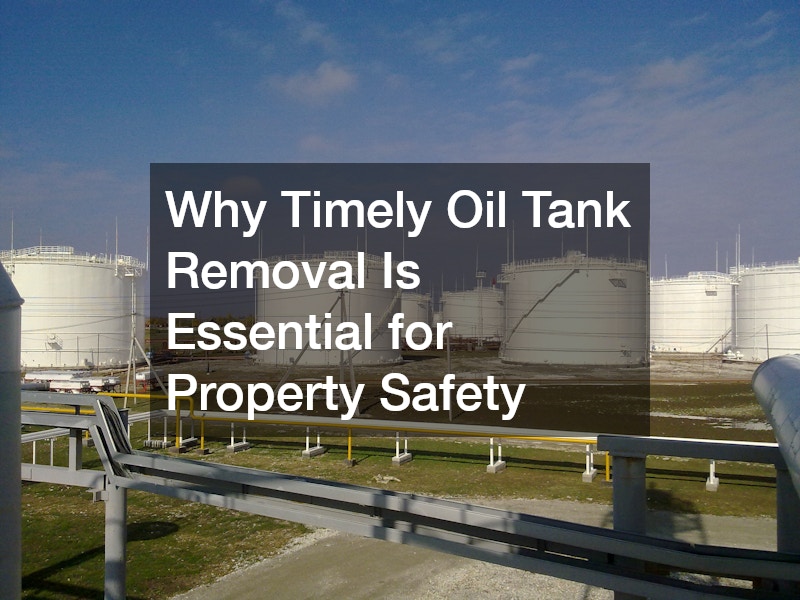Maintaining property safety necessitates attention to a variety of potential hazards, with old and unused oil tanks presenting significant concerns. These tanks, often remnants of outdated heating systems, can pose serious environmental and safety threats if not addressed properly. Timely removal of such oil tanks is crucial to mitigating risks such as soil contamination, financial liabilities, and even legal repercussions.
Environmental Hazards
Old oil tanks left to deteriorate can lead to leaks, resulting in soil and water contamination. When oil seeps into the ground, it can percolate down to the water table, affecting local wells and public water supplies.
The environmental impact is not only detrimental to ecosystems but poses direct health risks to humans and wildlife.
Surface spills and underground leaks from aging tanks can lead to extensive cleanup efforts, often necessitating costly soil remediation. The longer these tanks are left unmanaged, the greater the likelihood of widespread contamination. Property owners have both an ethical and legal responsibility to prevent such environmental disasters.
Financial Implications
The costs associated with cleaning up an oil spill can be exorbitant, particularly if contamination spreads beyond the immediate property border. Moreover, government agencies may levy fines on property owners who fail to manage their oil tanks properly. These financial implications underscore the importance of addressing oil tank issues before they escalate.
Neglected oil tanks can also depreciate the value of the property significantly, making the property less attractive to potential buyers. In some cases, failure to remove or properly manage an oil tank can lead to lawsuits, further increasing financial strain. Proactively removing oil tanks or repairing them when necessary can help avert such financial burden.
Legal Liabilities
Property owners are subject to both local and federal regulations regarding the management of oil tanks. Failing to comply with these regulations can result in hefty penalties and legal actions. Compliance involves regular inspection, maintenance, and removal if necessary, requiring owners to stay informed about their obligations.
In addition to fines, legal liabilities can arise if contamination extends to neighboring properties. Environmental laws are stringent, with a focus on protecting public health, making it imperative for owners to adhere to these regulations. Procrastination can result in elevated complications, legally and environmentally.
Increased Market Appeal
Properties with properly removed oil tanks often attract more potential buyers due to improved safety assurances. Buyers are wary of purchasing properties with potential liabilities, such as those presented by neglected oil tanks. Proper removal and documentation can provide buyers with peace of mind, increasing the property’s appeal in real estate markets.
Real estate agents often stress the importance of oil tank removals as a selling point, highlighting the reduced risk of contamination or future expenses. Market trends indicate a preference for environmentally conscious properties, making cleaned sites more attractive. Ensuring the removal of oil tanks can be a key component in differentiating a property within competitive markets.
Avoiding Future Costs
By removing oil tanks before they cause damage, property owners avoid costly future repairs and potential legal disputes. The costs associated with proactive removal pale in comparison to the expenses tied to cleaning up an oil spill. This foresight protects not only the immediate land but prevents a cascading effect of expenses.
Aging tanks can incur unplanned maintenance expenses due to corrosion and leakage if left unchecked. New homeowners face hefty repair bills if tanks are not managed appropriately by previous owners. The anticipation of such costs can deter potential buyers or result in lower offers.
Initial Assessment and Planning
The removal process begins with a detailed assessment to ascertain the condition of the oil tank and the potential risks involved. Professionals conduct site evaluations, checking for leaks, tank integrity, and soil contamination. This planning stage determines the scope of the removal and the necessary safety precautions.
Creating an individualized plan for removal requires understanding both environmental impact and regulatory compliance. Detailed records of the assessment phase ensure clarity and guide subsequent removal operations. Documented evaluations assist in managing expectations and delivering thorough remediation solutions.
Choosing a Licensed Professional
Hiring a licensed and certified professional is a vital step to ensure safe and compliant oil tank removal. These experts possess the technical skills and legal knowledge necessary to conduct removals within the regulatory framework. Their expertise guarantees that operations are executed safely, reducing liabilities for property owners.
Professional services provide risk assessments, ensuring that no contamination is left unchecked or worsened during removal. They handle permits and documentation, coordinating with relevant authorities to maintain adherence to environmental regulations. This professionalism ensures the transition is smooth, reliable, and thoroughly accountable.
Post-Removal Inspection and Reporting
Upon completion of the removal, a detailed inspection is conducted to validate the successful extraction and site rehabilitation. This includes checking the cleanup’s efficacy, evaluating soil quality, and preparing environmental reports. These reports document compliance and maintain transparency for future reference.
Recognizing the essential nature of timely oil tank removal is imperative for maintaining property safety and value. By addressing potential hazards early, property owners avoid financial strain, legal repercussions, and environmental damage. Adopting a proactive, informed approach ensures property integrity, compliance with regulations, and enhances overall property value for current and future stakeholders.


